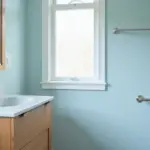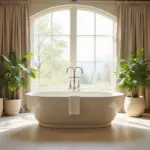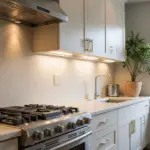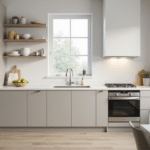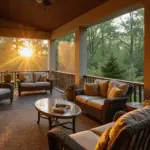For artists and creative professionals, a living room is more than just a place to relax—it’s an extension of your creative practice, a space where inspiration strikes, ideas develop, and artistic vision comes to life. The challenge lies in designing a space that supports your creative work while remaining comfortable and inviting for everyday living. This collection of fresh design ideas bridges that gap, offering thoughtful approaches to transform your living room into a dynamic environment that nurtures both your artistic expression and your need for restoration. Whether you’re a painter seeking the perfect light, a textile artist needing tactile inspiration, or a designer craving organized chaos, these curated suggestions will help you craft a living space that’s as unique and adaptable as your creative process.
1. Embrace a Neutral Base: The Foundation for Creative Expression
Why start with neutrals when designing a living room? For artists and creative professionals, a neutral base isn’t about playing it safe—it’s about creating a canvas for expression. Whites, creams, grays, and taupes provide a foundational palette that adapts effortlessly as your artistic vision evolves. This approach allows you to introduce color through your own artwork, textiles, and collected objects without committing to major renovations when inspiration strikes.

The magic of neutrals lies in their ability to create space for visual breathing room. In my work designing artist live-work spaces, I’ve found that neutral walls and major furniture pieces prevent visual competition with the art and creative elements that truly matter. They expand the perceived dimensions of your living room, creating an airy atmosphere that fosters creativity rather than constraining it.
- Try layering different shades of the same neutral color for subtle depth
- Incorporate varied textures—linen, wool, jute—to prevent flatness
- Remember that “greige” (gray-beige blend) works beautifully with both warm and cool tones
The inspiration for this collection struck when I realized how many artists struggle with creating a home that showcases their work without overwhelming their living space. As we look at grounding this neutral foundation, consider how a well-chosen rug can transform your living room design ideas from concept to reality.
2. Anchor the Room with a Show-Stopping Rug: Your Fifth Wall
A rug isn’t just something soft underfoot—it’s your fifth wall, a horizontal canvas that defines your creative territory. In studio apartments where living and working spaces merge, the right rug visually establishes boundaries without physical walls. It pulls disparate furniture elements together into a cohesive conversation and provides a tactile experience that changes how you interact with your space.

When selecting a rug for your artist’s living room, consider both practical and aesthetic elements. Size matters tremendously—a too-small rug makes everything feel disconnected and diminished. Ensure it’s large enough to accommodate at least the front legs of all seating pieces, or ideally, extends fully beneath them. For artists working with messy materials, darker patterns and natural fibers like wool can disguise inevitable creative accidents, while still providing comfort and acoustic benefits.
“The silhouette draws inspiration from the negative space in your room—your rug should define the area where creative conversation happens.”
Running your hand across this material reveals the true difference between mass-produced and artisan-made rugs. While your walls showcase vertical art, your floors can display horizontal art through a rug that reflects your personal aesthetic. Beyond the obvious placement, consider using smaller rugs to define separate work zones within an open living space.
3. Create a Captivating Gallery Wall: Your Visual Autobiography
What makes a gallery wall truly captivating in an artist’s living room? It’s not just about hanging frames—it’s about curating a visual narrative that evolves with your creative journey. Unlike traditional gallery walls that remain static, an artist’s display should feel alive and changeable, reflecting current inspirations and completed works. The magic happens when you mix your own creations with pieces that influence you, creating a dialogue between your work and your influences.

The unexpected environmental benefit comes from repurposing frames and materials you already have. Start by gathering pieces that genuinely move you—sketches from your process work, photographs from inspiring locations, small experimental pieces, and works by artist friends. Arrange them first on the floor, photographing different configurations until you find one that creates visual flow. Consider incorporating three-dimensional elements like small shelves for ceramics, plants, or collected objects that add depth to your flat works.
- Mix media types: drawings, paintings, photographs, textiles
- Vary frame styles for eclectic interest or match them for cohesion
- Include negative space to prevent visual overwhelm
- Add personal artifacts that tell your creative story
If you’ve struggled with similar rooms before, remember that gallery walls don’t need to be perfect or permanent. The designer’s secret here is to think of it as a rotating exhibition that can change seasonally or whenever new work emerges from your creative practice. This approach keeps your living room design ideas fresh and reflective of your artistic growth.
4. Reflect and Expand: Mirrors as Spatial Tools
The artisans behind these designs began with a problem many artists face—limited space that needs to function for both living and creating. An oversized mirror becomes more than decoration in a creative living room; it’s a spatial tool that visually doubles your square footage. For artists working in small spaces, this optical illusion creates breathing room that’s essential for creative thinking.

Beyond making rooms appear larger, mirrors serve as light amplifiers—particularly crucial in studio apartments where natural light affects both living comfort and artistic work. Position a large mirror opposite or adjacent to windows to capture and redistribute daylight throughout your space. This strategic placement not only brightens dark corners but can dramatically reduce the need for artificial lighting during working hours, providing the true color rendering that artists require.
“Unlike conventional options, this approach reduces visual constraint while enhancing the experience of existing architectural features.”
When clients ask us about balancing style with comfort, I often suggest leaning an oversized vintage mirror against a wall rather than hanging it. This casual placement creates a relaxed vibe while allowing for easy repositioning as your needs change. The craftsmanship reveals itself in details like patinated edges and subtle imperfections that add character to your living room design ideas.
5. Maximize Natural Light: The Artist’s Essential Resource
The environmental story behind this piece began with understanding how crucial quality light is for creative professionals. Natural light isn’t just a pleasant feature in an artist’s living room—it’s an essential resource that affects everything from mood to color perception to productivity. North-facing windows provide consistent, neutral light ideal for color-sensitive work, while south-facing windows offer dramatic light shifts throughout the day that can inspire different creative approaches.

If your living room suffers from limited natural light, consider how to maximize what you have. Remove heavy window treatments in favor of sheer fabrics that filter light without blocking it. Position reflective surfaces strategically to bounce available light deeper into your space. Paint walls in light, reflective colors with slight undertones that warm or cool the quality of light based on your preferences. For artists dealing with harsh direct sunlight, consider window films that diffuse light without darkening the room—essential for protecting artwork from UV damage while maintaining brightness.
- Regularly clean windows inside and out to maximize light transmission
- Position your main seating area to take advantage of the best natural light
- Consider a skylight or sun tunnel for dramatically improved illumination
- Use light-colored, reflective surfaces on walls adjacent to windows
What surprises clients most is how this works with even the most challenging spaces. In my experience designing artist live-work spaces, I’ve transformed north-facing rooms from dull to luminous by understanding how light moves and reflects. The magic of this piece lies in its ability to transform not just how your living room looks, but how it functions for creative work.
6. Prioritize Comfort: Design for Creative Endurance
The maker’s journey from apprentice to master influenced my approach to seating in artists’ living rooms. Comfort isn’t a luxury—it’s a necessity for creative professionals who often use their living spaces for extended work sessions. The right seating supports proper posture during long sketching sessions, accommodates different working positions, and prevents the physical strain that can interrupt creative flow.
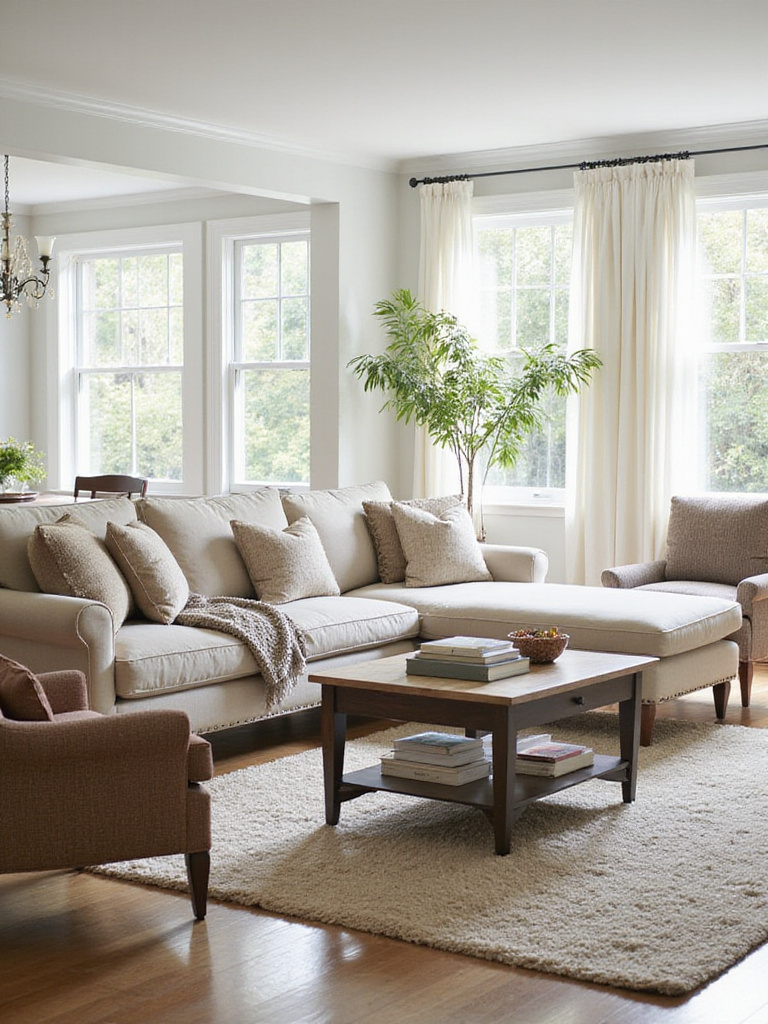
When designing for artists, I recommend a thoughtful mix of seating types rather than a matching set. A deep, comfortable main sofa provides relaxation and can double as a napping spot during intensive work periods. Complement this with at least one supportive armchair with proper back alignment for focused work. Consider including floor cushions or poufs that allow for working on large pieces spread across the floor—a common need for many visual artists. The tactile experience changes the entire room’s energy when materials are chosen for both sensory appeal and practical durability.
- Look for removable, washable covers on upholstered pieces
- Test seating before purchasing to ensure it supports your working posture
- Include at least one seat wide enough to accommodate reference materials beside you
- Consider antimicrobial fabrics if you frequently work with art materials in your living space
The challenge of awkward spaces becomes easier when you prioritize adaptable comfort. For those hesitant about bold patterns, consider introducing them through smaller, changeable elements like throw pillows that can be easily switched as your aesthetic preferences evolve. These living room design ideas focus on creating a space that supports your creative practice rather than just looking beautiful.
7. Layer Your Lights: Create Flexible Illumination for Art and Life
The unexpected color story emerging this year recognizes that artists need different lighting for different activities. A well-designed lighting plan for a creative living room should include at least three layers: ambient lighting for general illumination, task lighting for detailed work, and accent lighting to highlight artwork and create atmosphere. This layered approach allows you to transform the mood and functionality of your space throughout the day and for different creative pursuits.

For ambient lighting, consider fixtures that distribute light evenly without harsh shadows—ceiling-mounted fixtures with diffusers or indirect lighting that bounces off walls and ceilings. Task lighting becomes crucial for detail work; adjustable floor or desk lamps with articulating arms allow you to direct light precisely where needed. For accent lighting, consider track lighting with adjustable heads to highlight your artwork, creating gallery-like drama in your living space. The revival of this classic form comes with a twist—many newer fixtures offer adjustable color temperature, allowing you to switch between energizing cool light for daytime work and warmer, relaxing light for evening.
“The ambiance evolves throughout the day as natural light transitions to carefully planned artificial illumination.”
Even in smaller spaces, here’s how this works: install dimmer switches on all fixed lighting to adjust intensity based on your needs. The cultural heritage preserved in each piece includes understanding how light affects both our perception of art and our circadian rhythms. These living room design ideas acknowledge that proper lighting isn’t just about visibility—it’s about supporting the full spectrum of creative and personal activities that occur in your space.
8. Bring the Outdoors In: Nature as Creative Catalyst
The artisan collective that creates these pieces understands that natural elements are more than decorative—they’re creative catalysts. Plants, natural materials, and organic forms have profound effects on cognitive function and creative thinking. In my work with artists’ living spaces, I’ve observed how incorporating nature transforms not just the aesthetics but the entire creative energy of a room.

Beyond their visual appeal, plants improve air quality by filtering toxins—particularly important in spaces where artists might use materials that off-gas. Strategic placement can create natural divisions in open-plan living rooms, defining work and relaxation zones without solid barriers. Consider plants with different heights, textures, and growth habits to create visual rhythm. Snake plants and ZZ plants tolerate inconsistent care schedules—perfect for artists deep in creative flow who might forget regular watering. The sustainable journey of this material involves selecting plants that thrive in your specific light conditions rather than fighting to keep unsuitable species alive.
- Group plants of varying heights for dimensional interest
- Use large plants to divide functional areas in open-plan spaces
- Select low-maintenance varieties that won’t distract from creative work
- Consider the acoustic benefits of plants in reducing echo in high-ceilinged spaces
The collaboration began with a conversation about how natural materials can ground and center creative minds that often operate in abstract realms. While designed for the living room, we’ve seen creative uses in studio spaces where natural elements provide visual breaks from intense focus work. These living room design ideas recognize that connection to nature isn’t just aesthetically pleasing—it’s biologically necessary for creative well-being.
9. Play with Textures: Create Sensory Richness for Creative Minds
What makes this design special is the way it acknowledges artists’ heightened sensory awareness. Creative professionals often experience enhanced sensitivity to tactile qualities, making texture an essential element in living room design. Varying textures stimulates the brain, sparks creative associations, and provides subtle sensory experiences that can inspire new artistic directions. In a neutral-based living room, texture becomes the primary source of visual and tactile interest.

Layer textures thoughtfully to create a rich sensory environment without visual chaos. Begin with larger textural elements like a nubby bouclé sofa or a richly grained wood coffee table. Add medium-scale textures through window treatments, throw blankets, and area rugs. Complete the composition with small-scale textural accents in pillows, ceramics, and decorative objects. The interplay between the colors creates subtle dimension even within a limited palette. Consider how textures change under different lighting conditions—rough surfaces create interesting shadows, while smooth surfaces reflect light.
- Contrast smooth surfaces (glass, polished wood) with rough textures (woven fibers, stone)
- Include at least one unexpected textural element that invites touch
- Consider acoustic textures that absorb sound—important in creative spaces
- Look for textural elements that can double as impromptu still-life subjects
The finishing touch that elevates the entire look comes from understanding how textures photograph. For artists who share their living spaces on social media or use them as backgrounds for photographing their work, textural variety creates visual interest without competing with the artwork itself. This piece transitions beautifully between seasons with just minor adjustments to textiles and accessories.
10. Invest in Multifunctional Furniture: Adaptable Pieces for Creative Living
The third-generation workshop where this comes to life specializes in furniture that serves multiple purposes—essential for artists whose living rooms often double as studios, galleries, and meeting spaces. Multifunctional furniture isn’t just space-efficient; it’s creatively liberating, allowing your living room to transform based on your current project needs. The material sourcing makes all the difference in how these pieces perform over years of intensive use.

When selecting multifunctional pieces, prioritize quality construction and mechanisms that will withstand frequent reconfiguration. Consider nesting tables that can spread out for project work, storage ottomans that hide art supplies while serving as extra seating, and sofas with removable sections that can be rearranged for different activities. Look for coffee tables with adjustable heights that can transition from casual seating arrangements to work surfaces. The quality becomes evident after years of use when these pieces continue to function smoothly despite constant adaptation to your changing needs.
“Unlike single-purpose decor, this adapts to the evolving requirements of creative work.”
For those worried about maintenance, select pieces with durable, cleanable surfaces that can withstand occasional art material spills. The styling mistake most people make is choosing multifunctional pieces that prioritize mechanism over quality—resulting in furniture that fails precisely when you need its adaptability most. These living room design ideas recognize that for artists, furniture isn’t static—it’s an active participant in the creative process.
11. Design a Striking Focal Point: Create Visual Anchor in Creative Chaos
The discovery of this technique happened when I noticed how many artists’ living rooms felt visually scattered without a central anchoring element. A well-designed focal point does more than attract attention—it organizes the entire visual field of your living room, creating a hierarchy that helps the eye make sense of creative abundance. For artists whose homes often contain collections of inspiring objects, artwork, and materials, this organizing principle is essential.

Rather than defaulting to the television as your focal point, consider alternatives that better reflect your creative identity. A dramatic large-scale artwork—perhaps your own signature piece—makes a powerful statement. A uniquely designed fireplace surrounded by built-in shelving for rotating displays of smaller works creates both visual focus and functional storage. Even a distinctive architectural feature like exposed brick or a dramatic window can serve as a focal point when properly emphasized. The materials are sourced from a remarkable region where traditional craftsmanship informs contemporary design, creating pieces with both visual impact and authentic character.
- Position seating to naturally direct attention toward your focal point
- Ensure your focal point reflects your personal creative aesthetic
- Use lighting to emphasize and enhance your chosen focal element
- Allow adequate negative space around the focal point to prevent visual competition
When your existing decor doesn’t seem to coordinate, a well-chosen focal point can unify disparate elements by providing a visual anchor. Picture the warmth of evening conversations around a central feature that expresses your artistic vision. These living room design ideas acknowledge that in creative spaces, visual organization is as important as physical organization.
12. Showcase Your Treasures: Display Collections with Artistic Intent
The evolution of this trend reflects broader cultural shifts toward meaningful curation rather than mass consumption. For artists, displaying collections isn’t about accumulation—it’s about creating thoughtful arrangements that inspire and inform creative work. Whether you collect ceramics, art books, vintage objects, or natural specimens, how you display these items transforms them from mere possessions into a curated experience that enriches your creative practice.

Approach your shelving and display units as composition exercises. Consider the principles of balance, rhythm, and negative space that you apply in your artwork. Group similar items together for visual impact, or create unexpected juxtapositions that spark new ideas. Vary the heights and depths of displayed objects to create dimensional interest. The design language evolved from traditional patterns that emphasized symmetry to more dynamic, asymmetrical arrangements that draw the eye through the composition. Remember that negative space is as important as the objects themselves—allow breathing room around special pieces to emphasize their importance.
- Rotate displayed collections seasonally to maintain fresh inspiration
- Use adjustable shelving that can accommodate changing collection sizes
- Incorporate lighting that highlights special pieces
- Mix utilitarian storage with display areas to maintain functionality
Many homeowners wonder how to balance showcasing collections with maintaining a serene environment. The designer’s attention to detail shows in thoughtful curation—being selective about what you display rather than showing everything at once. These living room design ideas recognize that for creative professionals, collections are not just decorative—they’re resources that fuel the artistic process.
13. Centerpiece Coffee Table: The Studio Surface in Your Living Room
Look closely and you’ll notice the subtle texture of a well-designed coffee table that serves both living and creative functions. For artists, the coffee table often becomes an impromptu work surface, reference library, and display area. Selecting the right table means considering both its aesthetic contribution and its practical functionality for creative activities that spill over from dedicated studio spaces into living areas.

Consider materials that age beautifully with use rather than requiring pristine protection. Wood with a durable, repairable finish can develop a patina that records your creative journey. Glass tops allow for viewing collections displayed underneath while providing a cleanable surface for art materials. Large tables with drawers or shelves underneath provide storage for sketchbooks and reference materials you want to keep accessible. The craftsmanship in this collection tells a story of understanding how artists actually live—designing for real creative processes rather than idealized notions of pristine living spaces.
“Beyond aesthetics, the ecological impact matters because sustainable materials create healthier environments for sensitive creative work.”
If you’ve struggled with coffee tables that don’t accommodate your creative lifestyle, consider custom options made from unexpected materials like salvaged architectural elements or industrial components. The unexpected pairing that always works is a substantial table with lightweight portable trays that can be moved to different seating areas when you need to work away from the central space. These living room design ideas acknowledge that for artists, every surface is potentially a creative surface.
14. Infuse Your Personality: Authentic Expression Beyond Trends
The maker’s journey from apprentice to master influenced my understanding that truly successful living room design ideas for artists must reflect authentic personal expression rather than following trends. Your living room should be as individual as your creative work—a space that visually communicates your artistic perspective, influences, and sensibilities. This doesn’t mean displaying only your own artwork, but rather approaching the entire room as a composition that reflects your unique creative vision.

Resist the urge to create a space that looks like a design magazine or social media post. Instead, allow your living room to evolve organically as you collect meaningful objects, furniture, and art that resonates with your personal aesthetic. Mix high and low, vintage and contemporary, polished and raw elements to create tension and visual interest. The heritage technique gets a contemporary update through personalizing traditional design approaches with your individual perspective. Consider how color, form, texture, and composition—the elements you work with in your art—translate into three-dimensional space.
- Incorporate elements from different cultures that have influenced your work
- Display tools of your craft as decorative elements
- Use color relationships that reflect your artistic palette
- Allow your space to evolve rather than decorating it all at once
The environmental story behind this piece began with rejecting disposable design trends in favor of authentic expression that stands the test of time. For artists, living room design ideas should support creative thinking rather than conforming to external expectations of what a living room “should” look like. When your space authentically reflects your creative identity, it becomes both a comfortable haven and a source of ongoing inspiration.
15. Declutter and Organize: Create Visual Clarity for Creative Thinking
We challenged ourselves to reimagine how artists can maintain organized living spaces without sacrificing creative spontaneity. For creative minds, clutter isn’t just an aesthetic issue—it’s a cognitive one. Visual chaos competes for attention with the creative work at hand, making it harder to focus and develop ideas. Yet many artists resist overly minimalist spaces that feel sterile and uninspiring. The solution lies in thoughtful organization that supports creative processes while maintaining visual clarity.

Develop systems that accommodate the realities of creative work—materials that need to remain accessible, works in progress, and reference materials. Consider open shelving for frequently used supplies, closed storage for items used less often, and designated display areas for rotating works in progress. The professional stylists approach this by first identifying your specific creative patterns—are you someone who needs to see all your materials to feel inspired, or do you work better with a clear surface and materials stored away? Create organizational systems that work with your natural tendencies rather than against them.
- Use clear containers to store visually interesting materials
- Implement a regular reset routine to prevent creative chaos from becoming permanent
- Designate specific areas for works in progress
- Create boundaries between living and working zones, even in shared spaces
For those hesitant about bold patterns, organization provides the visual breathing room that allows you to incorporate more dynamic elements without overwhelming the space. The visual weight balances perfectly when organized areas offset more expressive, creative zones. These living room design ideas recognize that for artists, organization isn’t about rigid control—it’s about creating the conditions for creative freedom.
16. Zone Your Space: Define Creative and Living Areas
The inspiration for this collection struck when observing how many artists struggle with the boundaries between creative work and relaxation in shared spaces. Zoning your living room isn’t about rigid separation—it’s about creating intuitive transitions between different functions. Even in a studio apartment, thoughtful zoning helps your brain recognize when you’re in work mode versus relaxation mode, improving both creative focus and genuine rest.

Consider both physical and visual strategies for defining zones. Area rugs can delineate different functional areas without walls. Furniture arrangement creates natural boundaries—a bookcase placed perpendicular to a wall can separate a work area from a conversation area. Lighting plays a crucial role in zoning; different brightness levels and color temperatures can signal to your brain when you’re in a creative zone versus a relaxation zone. The composition comes together when you consider traffic flow between zones, ensuring that movement feels natural and intuitive rather than awkward or constrained.
- Use consistent color palettes within zones for visual cohesion
- Consider acoustic needs when zoning—creative work may require sound absorption
- Ensure each zone has appropriate storage for its function
- Allow for flexible boundaries that can shift based on current projects
Even in smaller spaces, here’s how this works: a daybed that functions as seating during the day and a bed at night, a dining table that transforms into a work surface, or a media center that conceals creative supplies. The magic of this piece lies in its ability to support different modes of being within a single space. These living room design ideas acknowledge the fluid nature of creative living and working.
17. Smart Storage Secrets: Conceal Creative Materials in Plain Sight
After months of sourcing and curation, we discovered that storage solutions for artists’ living rooms must balance accessibility with visual harmony. Creative work requires materials to be easily available when inspiration strikes, yet having supplies visible at all times can make relaxation difficult. The solution lies in storage systems that keep materials organized and accessible without creating visual clutter that distracts from both creative work and relaxation.

Look for furniture pieces with hidden storage capabilities—ottomans with lift-up tops for storing current project materials, coffee tables with drawers for sketching supplies, or side tables with concealed compartments for tools you use regularly. Consider modular storage systems that can be reconfigured as your creative practice evolves. The environmental benefit comes from selecting pieces made from sustainable materials with non-toxic finishes—particularly important for storing art supplies that may be sensitive to chemical interactions. Invest in quality storage pieces that will withstand frequent use rather than disposable solutions that contribute to landfill waste.
“When clients ask us about balancing style with comfort, we recommend storage solutions that reflect the same aesthetic as your visible furniture.”
The styling secret here is to select storage pieces that contribute to your overall design scheme rather than appearing purely utilitarian. A vintage cabinet can store art supplies while adding character; a beautiful basket collection can organize materials while serving as decorative elements. These living room design ideas recognize that for artists, storage is not just functional—it’s an integral part of creating a space that supports both creative work and daily living.
18. Cultivate a Warm Ambiance: Create Atmosphere for Creative Flow
The materials are sourced from a remarkable region where traditional craft techniques create lighting and textiles that transform atmosphere. For artists, ambiance isn’t just about aesthetics—it’s about creating conditions that support different creative states. Warm, layered lighting and rich textures can induce the relaxed, open mental state where creative connections often emerge. Conversely, cooler, more focused lighting can support detailed work and analytical thinking.

Develop a lighting plan that includes adjustable options for different creative modes. Include floor and table lamps with articulating arms that can be repositioned for specific tasks. Consider the color temperature of your bulbs—warmer lights (2700-3000K) create a cozy, reflective atmosphere, while cooler lights (4000K+) support detail-oriented work. Layer in textural elements that add warmth and acoustic benefits—crucial for creative spaces where sound quality affects concentration. Thick curtains, upholstered furniture, textured wall hangings, and area rugs all contribute to a warmer acoustic environment that feels enveloping and supportive.
- Install dimmer switches on overhead lighting for adjustable brightness
- Include at least one unexpected lighting element like a sculptural lamp or projection light
- Layer textiles of varying weights and textures for dimensional warmth
- Consider scent as part of your ambiance—natural essential oils can support different creative states
The emotional response this evokes begins with a sense of safety and comfort—necessary conditions for creative risk-taking. Imagine coming home to the gentle glow of adjustable lighting that can match your mood and creative needs. These living room design ideas recognize that atmosphere isn’t superficial—it’s foundational to both creative work and personal wellbeing.
19. Go Green: Sustainable Choices for Creative Consciousness
We’ve been working behind the scenes on something special—living room design ideas that support both creative practice and environmental responsibility. For many artists, sustainability isn’t just a preference but an extension of creative values—a recognition that our choices as makers and consumers have broader impact. Sustainable design in the living room means selecting materials, furniture, and accessories with consideration for their environmental footprint and long-term durability.

Prioritize natural, renewable, and non-toxic materials that create healthier indoor environments for sensitive creative work. Look for solid wood furniture from responsibly managed forests, organic textiles free from harmful chemicals, and paints and finishes with low or no VOCs (volatile organic compounds). Consider the entire lifecycle of items you bring into your space—can they be repaired, repurposed, or responsibly recycled at the end of their useful life? The renewable resources used here demonstrate that sustainable choices don’t require aesthetic compromise; they often offer richer textures, more interesting variations, and deeper connections to natural processes that can inform creative work.
- Choose vintage or secondhand furniture to reduce resource consumption
- Select textiles made from organic or recycled materials
- Look for locally made items to reduce transportation impacts
- Invest in quality pieces that will last decades rather than years
The traditional methods used result in furniture and accessories with character that mass-produced items can’t replicate. Beyond aesthetics, the ecological impact matters because many artists work with sensitive materials that can be affected by off-gassing from synthetic furnishings. These living room design ideas acknowledge that for creative professionals, sustainable choices support both environmental values and the conditions for healthy creative practice.
Conclusion: Your Living Room as Creative Catalyst
These 19 living room design ideas offer more than aesthetic improvement—they create environments where creative thinking flourishes naturally. By thoughtfully implementing these strategies, you’re not just decorating a space; you’re designing a personal ecosystem that supports both your artistic practice and your need for comfort and renewal.
Remember that the most successful artist’s living room evolves organically over time, reflecting your changing interests and creative directions. Allow your space to grow with you, adapting to new projects and inspirations. The living room that truly works for a creative professional isn’t a static showpiece but a dynamic environment that responds to the rhythms of your creative life.
As you implement these living room design ideas, trust your artistic instincts. You already understand composition, color, and form—apply these same principles to your three-dimensional living space. Your unique perspective is what will transform these guidelines into a living room that’s not just beautiful, but authentically yours—a true extension of your creative vision.

